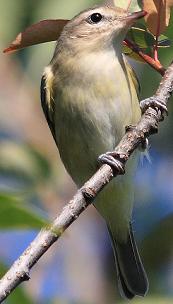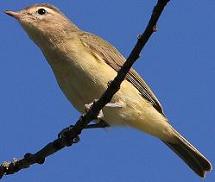Warbling Vireo

Identification and Pictures
(Vireo gilvus)
Warbling vireo is a small North American
song bird, about 5 1/2 inches, somewhat like a wood warbler.
Unlike some vireos, this one
does not have wing bands. They have a dull greenish back, olive-gray on the head,
with a light eyebrow stripe that arches above a dark
eye, and they are whitish below. Western birds have
yellow below and on the sides. They have a stout
bill, and thick blue gray legs. Male, and female
birds look the same. They are often difficult to
spot, being easier to locate by their song.
Photos by Keith Lee.
The camera I use is the Canon
EOS 40D. Visit All-birds store
Range and Habitat
 Warbling
vireos range across most of the U.S., and much of Canada
in summer, migrating south to Mexico, and Central America
for the winter. They like deciduous
shade trees, and mixed woods, cottonwoods, willow,
aspens, riparian woodlands, and pastures. They
prefer forest edges, and trees near river, and stream
banks. They are most often found in high tree
tops. Warbling
vireos range across most of the U.S., and much of Canada
in summer, migrating south to Mexico, and Central America
for the winter. They like deciduous
shade trees, and mixed woods, cottonwoods, willow,
aspens, riparian woodlands, and pastures. They
prefer forest edges, and trees near river, and stream
banks. They are most often found in high tree
tops.
Breeding and Nesting
Vireos are monogamous. Breeding is
late May through July. Both members of a pair will
build a basket like nest that hangs from a forked tree
branch or shrub. The nest is made of grass,
leaves, bark strips, plant fibers, lichen, hair, and
spider webs. They incubate 4 smooth, white eggs
for 12 to 14 days. The male helps in incubations,
and will often sing from the nest. Both parents
will care for the young birds for around 2 weeks in the nest,
and another 2 weeks after they fledge.
Song and Call
Their song is a weak, cheerful
warble. Call note is a wheezy twee. Listen
to sound
Food
Vireos eat insects, spiders, snails, berries, and fruit.
They forage mostly in tree tops, by hopping around
branches, and also hovering in the air to grab insects.
To learn about other
favorite birds click here.

|
|
|
 All-birds Store
All-birds Store
Bird Watching guides, books, binoculars,
cameras, gifts for bird lovers, bird baths, feeders
and more... baths, feeders
and more...
|
|
|
RECOMMENDED READING
Available for Immediate
Download

Click
here
|
|
